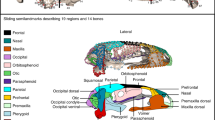Abstract
Organisms are self-producing and self-maintaining, or ‘autopoietic” systems. Therefore, the course of evolution and adaptation of an organism is strongly determined by its own internal properties, whatever role “external” selection may play. The internal properties may either act as constraints that preclude certain changes or they open new pathways: the organism canalizes its own evolution. As an example the evolution of feeding mechanisms in salamanders, especially in the lungless salamanders of the family Plethodontidae, is discussed. In this family a large variety of different feeding mechanisms is found. The authors reconstruct this evolutionary process as a series of “bifurcation points” of either constraints or opportunities forming a sequence of preconditions for the formation of a high-speed projectile tongue characteristic of tropical salamanders. Furthermore, it is shown how parallel evolution of seemingly unrelated domains within an organism such as respiratory physiology, life history biology and pattern of ontogeny has rather direct relevance to the feeding biology, thus demonstrating that organisms always evolve as wholes.
Similar content being viewed by others
References
an der Heiden, U., Roth, G., and Schwegler, H. (1984). Principles of self-generation and self-maintenance.- This volume.
Bramble, D.M., and Wake, D.B. (1985). The feeding mechanism of lower tetrapods. In M. Hildebrand, D.M. Bramble, K.F. Liem and D.B. Wake, eds., Functional Vertebrate Morphology. Cambridge, MA: Harvard University Press.
Dullemeijer, P. (1974). Concepts and approaches in animal morphology. Assen: Van Gorcum.
Hinderstein, B. (1971). The desmognathine jaw mechanism (Amphibia: Caudata: Plethodontidae).- Herpetologica 27: 467–476.
Larsen, J.H., and Guthrie, D.J. (1975). The feeding system of terrestrial tiger salamanders (Ambystoma tigrinum melanostictum Baird).- J Morph 147: 127–154.
Larson, A. (1984). Neontological inferences of evolutionary pattern and process in the salamander family Plethodontidae.- Evol Biol 17: 1–99.
Larson, A., Wake, D.B., and Yanev, K.P. (1984). Measuring gene flow among populations having high levels of genetic fragmentation. Genetics 106: 293–308.
Lombard, R.E., and Wake, D.B. (1976). Tongue evolution in the lungless salamanders, family Plethodontidae. I. Introduction, theory and a general model of dynamics.- J Morph 148: 265–286.
Lombard, R.E., and Wake, D.B. (1977). Tongue evolution in the lungless salamanders, family Plethodontidae. II. Function and evolutionary diversity.- J Morph 153: 39–80.
Maiorana, V.C. (1978). Behavior of an unobservable species: diet selection by a salamander. Copeia 1978: 664–672.
Maturana, H.R., and Varela, F. (1980). Cognition and autopoiesis. Boston: Reidel
Özeti, N., and Wake, D.B. (1969). The morphology and evolution of the tongue and associated structures in salamanders and newts (family Salamandridae).- Copeia 1969: 91–123.
Piatt, J. (1935). A comparative study of the hyobranchial apparatus and throat musculature of the Plethodontidae.- J Morph 57: 213–251.
Rettig, G., and Roth, G. (1982). Afferent visual projections in three species of lungless salamanders (family Plethodontidae).- Neuroscience Letters 31: 221–224.
Roth, G. (1976). Experimental analysis of the prey catching behavior of Hydromantes italicus Dunn (Amphibia, Plethodontidae).- J comp Physiol 109: 47–58.
Roth, G. (1982). Conditions of evolution and adaptation in organisms as autopoietic systems. In D. Mossakowski and G. Roth, eds., Environmental adaptation and evolution, 37–48. New York: G. Fischer
Roth, G., Grunwald, W., Linke, R., Rettig, G., and Rottluff, B. (1983). Evolutionary patterns in the visual system of lungless salamanders (family Plethodontidae).- Arch Biol Med Exp 16: 329–341.
Roth, G., Wake, D.B., Wake, M.H., and Rettig, G. (1984). Distribution of accessory and hypoglossal nerves in the hindbrain and spinal cord of lungless salamanders, family Plethodontidae.- Neuroscience Letters 44: 53–57.
Severtsov, A.S. (1971). The mechanism of food capture in tailed amphibians.- Dokl Akad Nauk SSSR Biol Sci Sect 197: 185–187 (translation).
Smith, L. (1920). The hyobranchial apparatus of Spelerpes bislineatus. J Morph 33: 527–583.
Thexton, A.J., Wake, D.B., and Wake, M.H. (1977). Tongue function in the salamander Bolitoglossa occidentalis.- Archs oral Biol 22: 361–366.
Waddington, C.H. (1966). Principles of development and differentiation. New York: MacMillan.
Wake, D.B. (1966). Comparative osteology and evolution of the lungless salamanders, family Plethodontidae.- Mems So Calif Acad Sci 4: 1–111.
Wake, D.B. (1982). Functional and developmental constraints and opportunities in the evolution of feeding systems in urodeles. In D. Mossakowski and G. Roth, eds., Environmental adaptation and evolution, 51–66. New York: G. Fischer.
Wake, D.B., Roth, G., and Wake, M.H. (1983). Tongue evolution in lungless salamanders, family Plethodontidae. III. Patterns of peripheral innervation.- J Morph 178: 207–224.
Wake, D.B., Roth, G., and Wake, M.H. (1983). On the problem of stasis in organismal evolution.- J theor Biol 101: 211–224.
Wilder, I.W., and Dunn, E.R. (1920). The correlation of lunglessness in salamanders with a mountain brook habitat.- Copeia 84: 63–68.
Author information
Authors and Affiliations
Rights and permissions
About this article
Cite this article
Roth, G., Wake, D.B. Trends in the functional morphology and sensorimotor control of feeding behavior in salamanders: An example of the role of internal dynamics in evolution. Acta Biotheor 34, 175–191 (1985). https://doi.org/10.1007/BF00046783
Issue Date:
DOI: https://doi.org/10.1007/BF00046783



